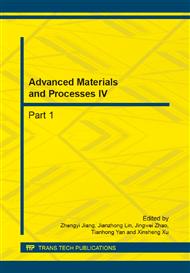[1]
CHen Qingliang, He Ning, Li Liang et al. Large feed program optimization and application of milling NC machining for titanium alloys [J]. Machine building and Automation, 2014, 43(1): 47-51.
Google Scholar
[2]
Jiang Zenghui, Wang Linlin, SHi Li et al. Tools wear mechanism and characteristics of cemented carbide to cut Ti6Al4V [J]. Journal of Mechanical Engineering. 2014, 50(1): 178-184.
Google Scholar
[3]
ZHao Wei, He Ning, Li Liang. Research on the friction and wear properties of WC-Co cemented carbide sliding against Ti6Al4V alloy in nitrogen gas [J]. Tribology. 2006, 26(5): 439-442.
DOI: 10.4028/www.scientific.net/amr.188.49
Google Scholar
[4]
L. Lebedeva, G. N. Presnyakova. Adhesion wear mechanisms under dry fiction of titanium alloys in vacuum[J]. Wear. 1991,Vol(148): 203-210.
DOI: 10.1016/0043-1648(91)90284-2
Google Scholar
[5]
A. Molinari, G. Straffelini, B. Tesi, T. Baxxi. Dry sliding wear mechanisms of the Ti6Al4V ally[J]. Wear. 1997,Vol(208): 105-112.
DOI: 10.1016/s0043-1648(96)07454-6
Google Scholar
[6]
Zhou Haibo, Zhang Jingjing, Yan Han etc. Research on tool wear mechanism and forecast method of Titanium alloy high speed milling [J]. Tool Engineering. 2014. 48(3): 18-22.
Google Scholar
[7]
Hiroyuki Saito, Akira Iwabuchi, Tomoharu Shimizu. Effects of Co content and WC grain size on wear of WC cemented carbide[J]. Wear. 2006,(261): 126-132.
DOI: 10.1016/j.wear.2005.09.034
Google Scholar
[8]
Ezugwu E O, Wang Z M. Titanium alloys and their machinability areview[J]. Journal of Materials Processing Technology. 1997,68(3): 262-274.
Google Scholar


